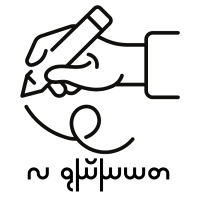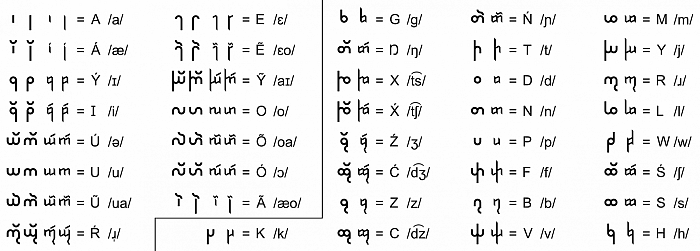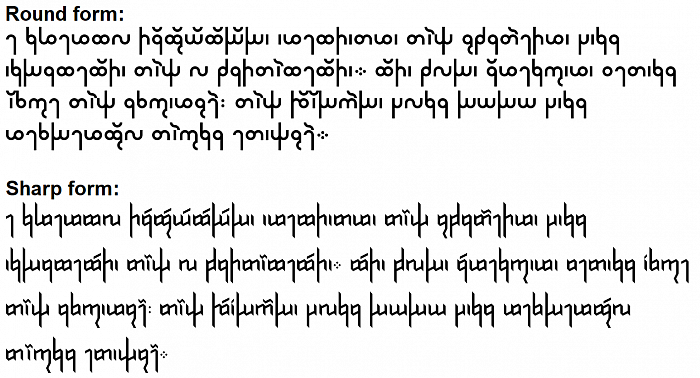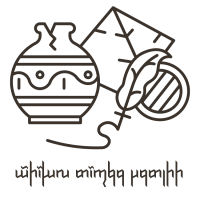Information about the Kynaatt Language
What is Kynaatt?
Kynaatt is a analytic agglutinative language. This means that the language relies heavily on word order, or the use of particular words, to describe the meaning of a sentence. Nouns only have a single form, unlike languages like Polish and German which heavily use case for the nouns. Agglutinative means that words are built using root words and suffixes that don't change when they're added to a word. Kynaatt makes use of enclitic determiners, or determiners (like "the house", "that house", "some house") that are attached at the end of the word as a part of it, instead of being separate words. Several counting words are also used as classifiers, separate from the word they are modifying, so a plural in Kynaatt is not written like a plural in English (for example "o toig" = "houses").
Writing Systems for Kynaatt
Kynaatt officially utilizes the Katemayar script for its publications. This is a constructed script developed from Atemayar Qelisayer, Eriseci, Georgian (Mkhedruli, Asomtavruli, & Nuskhuri), and Armenian. There are two forms of this script, round (seen in the image to the right), and sharp.
Kynaatt also uses 8 other scripts for varying reasons, and also has a standardized (but unofficial) Latin script (that you see on this website). While no single script is more important than another, works on this website in Translated Works will be solely published in Katemayar.
Due to Katemayar being a constructed script, it utilizes its own TTF font file to type in it, which cannot be used on Google Drive. Because of this, most instances of the text found online, such as on this website or within the Google Document for the Dictionary, the other scripts are used until this problem can be overcome.
Below you will find the alphabet charts for Katemayar so you can use it to write your own Kynaatt. If you submit a usage request or acknowledgement on the Contact Us page, you will receive the fonts for Katemayar.
Katemayar uses a different system of vowels, extended vowels have separate letters from the short form. The left pair of vowels is the short form, and right pair is extended. Both round and sharp forms are listed in the charts below.
A Brief History of Kynaatt
Kynaatt has been around in some form or another for 12 years now. Starting in 2010 as a collection of hypothetical languages for a video game, it has evolved into a fully formed, fully capable, general use language. It has gone through many versions, though the first fully formed language dictionary, which is labeled as the first edition, was formed in 2012. Few versions prior to the Eighth definition resemble modern Kynaatt in its current form.
This section will also include a brief description of the history of Mijriian, the far less developed sister language of Kynaatt (as seen in "Kyna-Mijriian Language Family).
Each section will have an example of the Kynaatt word for "good" to demonstrate changes over the iterations.
The first spelling of "Good": Duqeim
First Edition - Dexnokian
Kynaatt used to be called Dexnokian when it was first created. The made-up name of a video game world, "Dexnokia." It was an amalgamation of the remnants of the collection of languages prior to 2012. Prior to 2012, a notebook and a computer document were the only location for the language, and both were misplaced or lost. After a short hiatus without the notebook and document, Dexnokian was formed from memory of the original script, which led to many words changing meaning, and spelling methods changing.
Good: Duquiem
Second Edition - Lux / Lüx
Lux issued in many changes for the language. Dexnokian's word basis was largely based on English, and grammar was effectively English, and therefore the language operated closer to a code instead of an independent language. Lux created the first fully standardized dictionary, though still lacking most words. It was largely expanded with the influence of Germanic and English sounds and was with the exception of words being created from other languages, largely unique in its sound profile as it did not aspire to sound like any other language.
Good: Duquiem
Third Edition - Later Lux / Lüx
Later Lux was the transition from a random amalgamation of words collected together to a system of grammar and spelling. Spelling reforms were instituted, letters were added, consonant clusters introduced, and the pronunciation of words was standardized. This period was largely influenced by a Scandinavian-ization of the language, bringing in sounds and consonant mapping commonly found in Scandinavian languages. Words like "snakker" were added, and the consonant cluster "sk" became very prevalent in the language, as well as vocalic N.
Good: Dukuiem
Fourth Edition - Cheshkovakshevek
Cheshkovakshevek was the abandonment of the Scandinavian influence in regards to word creation, and rapid shift towards Western Slavic sounds, like those found in Czech and Polish. Letters were added to describe these sounds, and words quickly extended in length in order to include a collection of sounds resembling those languages. Scandinavian created words were largely untouched, giving the language a unique sound as if it were found in the middle of the Baltic Sea.
Good: Dukuiem
Fifth Edition - Cheskovak
Cheskovak was a reign in of the influence that Polish and Czech had on the language, and expanded influence to other languages. The language however was still largely made up of foreign influenced cognates, and still heavily utilized English grammar. However, it was at this time that the first instances of agglutination were added to the language. The system was complex, and largely defined by means of English fusions (such as "-ation", "-ize", "-sion", etc.), but allowed for a more universal suffix system for the language. It was however, still heavily fusional.
Good: Dukuiem
Sixth Edition - Early Kynaatt
Early Kynaatt was first named during this iteration. This version sought to expand the language wholly to a fully functional language. It involved largely foreign influenced words, but saw a collectivization of the suffixes for the agglutination, and establishment of suffixes to change word form (noun > verb, verb > noun, etc.) and saw a preference towards standardizing an official form of suffixes from a base word type.
Good: Dukuum
Seventh Edition - Middle Kynaatt
Middle Kynaatt is where the modern suffix system arose in entirety. Words were reduced to solely their noun forms, and all other word forms were given suffixes in order to change their types. This saw a reduction in words being created from foreign influence, but largely left the language as it was vocabulary wise, and influenced the grammatical structure.
Good: Dukuuma
Eighth Edition - Kynaatt
The Kynaatt Dictionary - Eighth Edition is the version that immediately precedes the current version of the language. It was differentiated by a two year program to remove foreign influence in the language's vocabulary, and standardize definitions and word use, as well as suffix placement across the existing vocabulary. Over 400 words were changed to be original to the Kynaatt language, several hundred were shortened in order to reduce the average word length to one to three syllables. Irregular word spelling was entirely removed in order to make Kynaatt phonetically spelled eliminating silent letters and other irregularities. It also involved the introduction and standardization of several diphthongs into the language, and led to over 800 new words being added to the dictionary. The dictionary during this time was heavily restructured and reformatted, as well as most of the determiners were created during this period. All instances of fusion in the language were effectively removed making it truly agglutinative, and the conjugations and suffixes led to Kynaatt becoming highly analytic during this time.
Good: Dukuuma
A Brief History of the Mijriian Language
The Mijriian language is Kynaatt's first, and most expansive sister language. It was formed in response to the e-document version of the very original language from prior to the First Edition of Kynaatt. That is how we know that "dukuuma" was originally spelled "duqeim." Mijriian captured many of the unique sound profiles from the original language that were lost in the evolution of Kynaatt, as well as remained untouched by the addition of further sounds added later on to Kynaatt. Mijriian also preserved, for a short time, the overly complex (and non-phonetic) spelling system of original Kynaatt (duqeim was pronounced "doo-koom"). This spelling system was later reformed into a similarly phonetic system to Kynaatt, utilizing letters from Kynaatt. Mijriian lacks any reduced vowel diphthongs like in Kynaatt (expressed with the ~), and many of the vowels reduced between the two languages (for example, "-yý" and "-ỹ" both reduced to "-ee" in Mijriian). The Mijriian language was developed alongside Kynaatt (early and middle) with linguistic evolutionary practices in mind with predictable changes occurring between the languages, Mijriian being the simplified version of Kynaatt without vowel length, many diphthongs, and fewer consonants.
